Buried plaque sends detectorist on WW1 quest
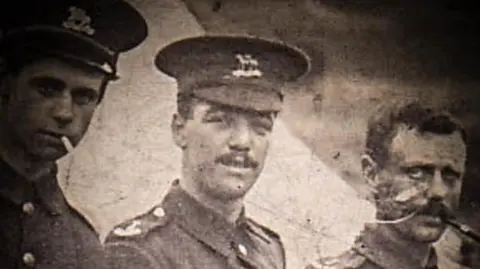 David Stuckey
David StuckeyMystery surrounds the story of a World War One soldier whose commemorative plaque led a keen metal detectorist to try to track down his family.
Amateur historian David Stuckey, from Stevenage, was detecting in a field in Bedfordshire in 1999 when he came across a battered bronze plaque bearing the name Robert Arthur Thompson.
Years later he made it his mission to find out more, and realised the soldier had enlisted under a different name, but was buried in France under his original name - Rupert Archibald Thompson.
Mr Stuckey eventually tracked down distant relatives in Buckinghamshire and Suffolk, but to this day no-one knows why Rupert became Robert, or how his plaque came to be lost in a county not related to any known family member.
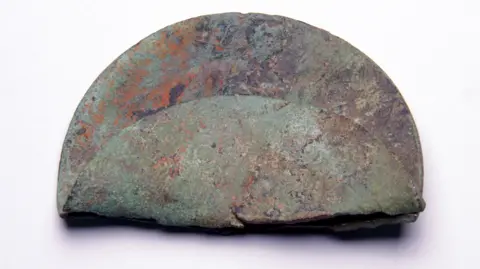 David Stuckey
David StuckeyWhen he found the plaque, Mr Stuckey initially thought it was a brass plate from an old tractor.
It was folded in half and there was seemingly nothing about it that caught his interest.
However, he took it home, put it away in a box of items labelled "detecting junk" and forgot about it.
A while later, he took it out and put it in a vice, in an attempt to straighten the disc in case that gave him further clues.
Unfortunately it broke in two, but it did reveal some details, including the figure of Britannia, a lion and a name - Robert Arthur Thompson.
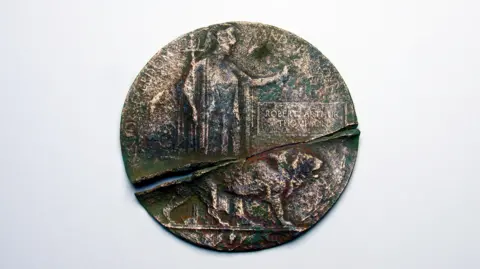 David Stuckey
David Stuckey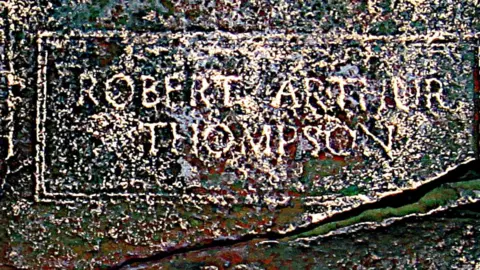 David Stuckey
David StuckeyThe bronze plaque itself was not that unusual, as more than one million were sent to the families of those who died in the Great War between 1914 and 1918.
About 12.5cm (5in) in diameter, they became known popularly as the Death Plaque, Dead Man’s Penny, or Widow’s Penny.
However, it was the name on this particular plaque that piqued the detectorist's interest.
A friend searched a list of those who died during World War One and found Thompson's name among them.
He had served as a sergeant in the 6th Battalion Queen's (Royal West Surrey) Regiment, and had lived in Carshalton, which is now part of the London Borough of Sutton.
The record stated he was killed in action on 4 April 1917 in France and his serial number was recorded as G/22548.
Mr Stuckey's friend then trawled the records of the Commonwealth War Graves Commission to try to track down his burial site.
"That's when it got interesting," said Mr Stuckey.
"Nothing came up under the soldier's name, so he put in the initials - RA - and it came up with the name of Rupert Archibald Thompson.
"All the other details were identical, and it stated he had died at the age of 30, and was buried at Faubourg D'Amiens cemetery in Arras, in France."
It was "now a bit of a mystery", said Mr Stuckey.
"Why did Rupert change his name when he joined the Army?"
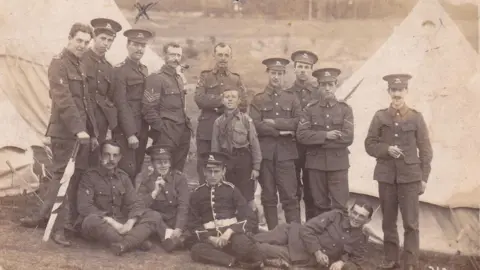 David Stuckey
David StuckeyWithout his own computer at that time, the plaque went back in its box, but years later, Mr Stuckey had another go at solving the mystery.
He found an extract from Sgt Thompson's regiment's war diary from the week in which he was killed.
It appeared that the unit was billeted in the basement of the museum in Arras and Mr Stuckey believed he was one of those killed when it was hit by a shell.
But the question why Rupert changed his name continued to haunt him.
Mr Stuckey said he had considered Rupert may have had a medical condition that precluded him from military service or he might have had a criminal record.
"I've had a rather fanciful theory that maybe he had a dalliance with a young lady, resulting in a pregnancy and rather than stay and face up to his responsibilities, where better to hide - join the Army under a false name and disappear," he pondered.
"But... maybe be he just didn't like his own name, Rupert Archibald - he wanted to a warrior's name."
Rupert did not have any known children, so Mr Stuckey began looking at other members of the family - most of whom were also childless.
But he found the eldest brother - Eric Thompson.
Eric had married and had three children with his wife Gertrude.
"It appeared that Eric had died in 1917, like his brother Rupert, serving in France," said Mr Stuckey.
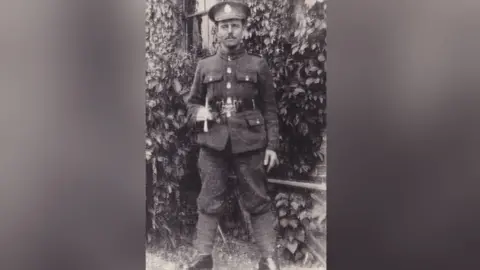 David Stuckey
David StuckeyHowever, he managed to track down two grandchildren of Eric and Gertrude - Alan, from Aylesbury in Buckinghamshire and his sister June, from Exning, in Suffolk.
Neither knew anything about their family's history as their ancestors had been split up after Gertrude's death in 1919 during the Spanish flu outbreak.
He met with them and said they were "absolutely gobsmacked - they knew precious little about any of the family's history - and were desperate to know more".
They had an old tin full of family photographs and letters but had no idea who the people were.
"I was able to tell them who everybody was, and they were absolutely ecstatic," Mr Stuckey said.
"All their family history was now being put into context."
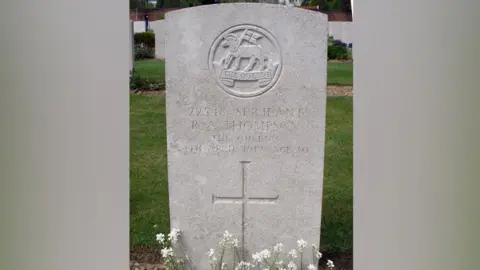 David Stuckey
David StuckeyOne of the photographs the relatives had showed a group of soldiers and on the back was written: "Rupert, third from left."
"I just could not believe it - here was the man on the plaque. And I can't tell you how I felt finally having a face to the name on that plaque - it was unbelievable," he said.
"It doesn't look like I'll get any answers to my big questions.
"I'm never going to know why he changed his name and I'm never going to know who buried his plaque in a field in Bedfordshire.
"But I was happy with what I'd got.
"It does go to show what amazing stories can emerge just by finding a piece of metal with a name on it."
Mr Stuckey still has the plaque and takes it to talks he gives at metal detecting clubs in East Anglia.
Follow Beds, Herts and Bucks news on BBC Sounds, Facebook, Instagram and X.
